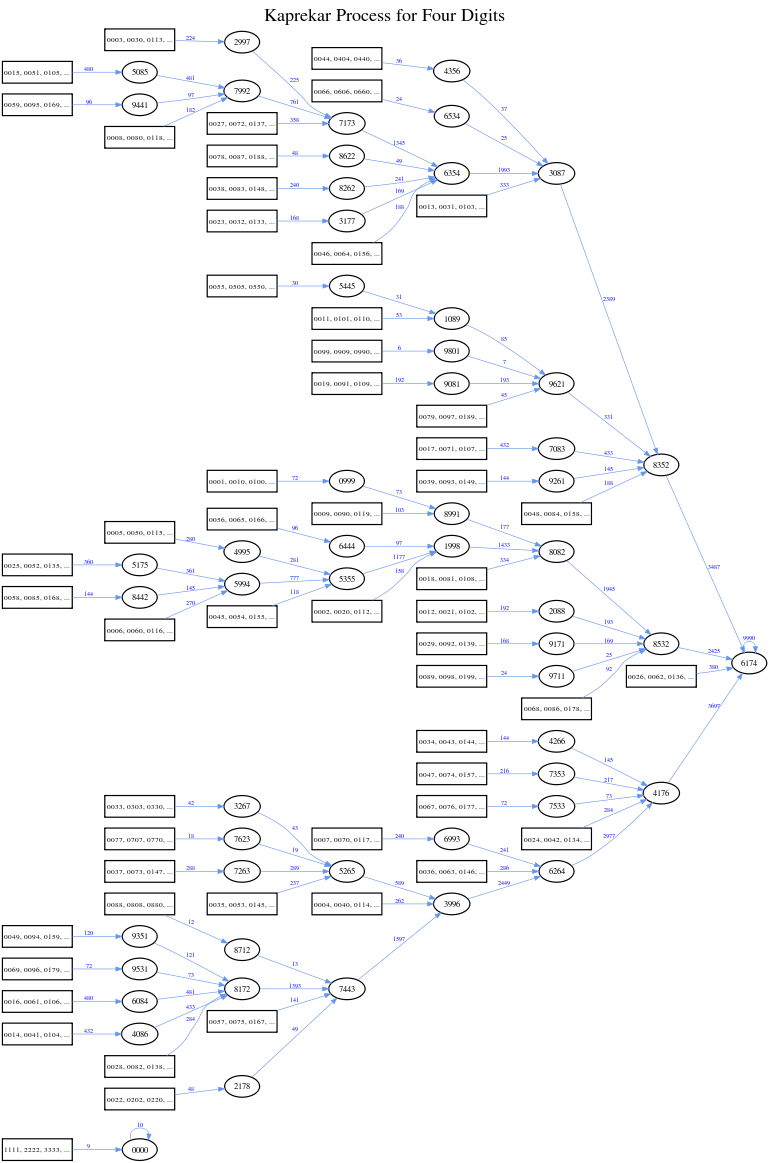6174 (number)
| ||||
|---|---|---|---|---|
| Cardinal | six thousand one hundred seventy-four | |||
| Ordinal |
6174th (six thousand one hundred and seventy-fourth) | |||
| Factorization | 2 × 32× 73 | |||
| Roman numeral | VMCLXXIV | |||
| Binary | 11000000111102 | |||
| Ternary | 221102003 | |||
| Quaternary | 12001324 | |||
| Quinary | 1441445 | |||
| Senary | 443306 | |||
| Octal | 140368 | |||
| Duodecimal | 36A612 | |||
| Hexadecimal | 181E16 | |||
| Vigesimal | F8E20 | |||
| Base 36 | 4RI36 | |||
6174 is known as Kaprekar's constant[1][2][3] after the Indian mathematician D. R. Kaprekar. This number is notable for the following property:
- Take any four-digit number, using at least two different digits. (Leading zeros are allowed.)
- Arrange the digits in descending and then in ascending order to get two four-digit numbers, adding leading zeros if necessary.
- Subtract the smaller number from the bigger number.
- Go back to step 2.
The above process, known as Kaprekar's routine, will always reach its fixed point, 6174, in at most 7 iterations.[4] Once 6174 is reached, the process will continue yielding 7641 – 1467 = 6174. For example, choose 3524:
- 5432 – 2345 = 3087
- 8730 – 0378 = 8352
- 8532 – 2358 = 6174
- 7641 – 1467 = 6174
The only four-digit numbers for which Kaprekar's routine does not reach 6174 are repdigits such as 1111, which give the result 0000 after a single iteration. All other four-digit numbers eventually reach 6174 if leading zeros are used to keep the number of digits at 4:
- 2111 – 1112 = 0999
- 9990 – 0999 = 8991 (rather than 999 – 999 = 0)
- 9981 – 1899 = 8082
- 8820 – 0288 = 8532
- 8532 – 2358 = 6174
9831 reaches 6174 after 7 iterations:
- 9831 – 1389 = 8442
- 8442 – 2448 = 5994
- 9954 – 4599 = 5355
- 5553 – 3555 = 1998
- 9981 – 1899 = 8082
- 8820 – 0288 = 8532 (rather than 882 – 288 = 594)
- 8532 – 2358 = 6174
4371 reaches 6174 after 7 iterations:
- 7431 - 1347 = 6084
- 8640 - 0468 = 8172 (rather than 864 - 468 = 396)
- 8721 - 1278 = 7443
- 7443 - 3447 = 3996
- 9963 - 3699 = 6264
- 6642 - 2466 = 4176
- 7641 - 1467 = 6174
8774, 8477, 8747, 7748, 7487, 7847, 7784, 4877, 4787, and 4778 reach 6174 after 4 iterations:
- 8774 – 4778 = 3996
- 9963 – 3699 = 6264
- 6642 – 2466 = 4176
- 7641 – 1467 = 6174
Note that in each iteration of Kaprekar's routine, the two numbers being subtracted one from the other have the same digit sum and hence the same remainder modulo 9. Therefore, the result of each iteration of Kaprekar's routine is a multiple of 9.

495 is the equivalent constant for three-digit numbers. For two-digit numbers, there is no equivalent constant; for any starting number with differing digits, the routine enters the loop (45, 9, 81, 63, 27, 45, … ). For each digit length greater than four, the routine may terminate at one of several fixed values or may enter one of several loops instead.[4]

Other numbers of digits
| Digits of the given number | Cycles | Cycles length | Number of cycles |
| 1 | {0} | 1 | 1 |
| 2 | {00}, {09, 81, 63, 27, 45} | 1, 5 | 2 |
| 3 | {000}, {495} | 1, 1 | 2 |
| 4 | {0000}, {6174} | 1, 1 | 2 |
| 5 | {00000}, {53955, 59994}, {61974, 82962, 75933, 63954}, {62964, 71973, 83952, 74943} | 1, 2, 4, 4 | 4 |
| 6 | {000000}, {420876, 851742, 750843, 840852, 860832, 862632, 642654}, {549945}, {631764} | 1, 7, 1, 1 | 4 |
| 7 | {0000000}, {7509843, 9529641, 8719722, 8649432, 7519743, 8429652, 7619733, 8439552} | 1, 8 | 2 |
| 8 | {00000000}, {43208766, 85317642, 75308643, 84308652, 86308632, 86326632, 64326654}, {63317664}, {64308654, 83208762, 86526432}, {97508421} | 1, 7, 1, 3, 1 | 5 |
See also
References
- ↑ Yutaka Nishiyama, Mysterious number 6174
- ↑ Kaprekar DR (1955). "An Interesting Property of the Number 6174". Scripta Mathematica. 15: 244–245.
- ↑ Kaprekar DR (1980). "On Kaprekar Numbers". Journal of Recreational Mathematics. 13 (2): 81–82.
- 1 2 Weisstein, Eric W. "Kaprekar Routine". MathWorld.
External links
| Wikimedia Commons has media related to Kaprekar's constant. |
- Bowley, Rover. "6174 is Kaprekar's Constant". Numberphile. University of Nottingham: Brady Haran.
- Sample (Perl) code to walk any four-digit number to Kaprekar's Constant